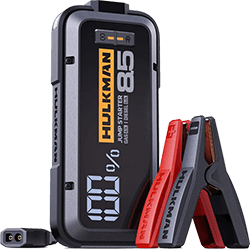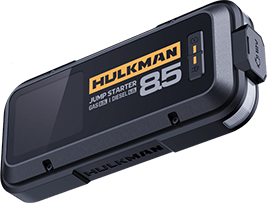Recent Articles
-
Mapping America’s Solar Landscape: Regional and Seasonal Variations November 11, 2025
-
Why Solva Solar Panels Stand Out: From Consumer’s Comment November 06, 2025
-
Unleashing Solar Power: Tips for Using and Maintaining Portable Solar Panels November 03, 2025
Featured Products
note
Can a Portable Power Station Stay Plugged in Long-Term?
Many people use portable power stations not just for road trips or emergencies, but as semi-permanent power hubs in homes and offices. Whether a unit like the Hulkman Mega can stay plugged into the wall long-term depends on battery chemistry, system design, and how it's configured. Understanding these factors helps prevent battery degradation and safety issues while maintaining convenience.
In this article, we’ll cover:
- Core Risks of Long-Term Plug-In
- Design Differences That Influence Safety
- Practical Setup for Hulkman Mega
- When Long-Term Plug-In Makes Sense
- Conclusion
Core Risks of Long-Term Plug-In
The most significant risk of leaving a lithium-based power station plugged in continuously comes from keeping the battery at or near 100% charge. When a battery remains fully charged for long periods, internal reactions accelerate, causing lithium plating and gradual capacity loss. Studies on NMC lithium cells show that long-term storage at maximum charge leads to noticeably faster degradation compared to storing at moderate charge levels.(IOPscience)
There’s also the issue of the battery management system (BMS), which remains active as long as the device is plugged in. Constant monitoring, current control, and protection functions stress circuits over time, increasing chances of heat accumulation and minor electrical strain. External conditions worsen these effects: temperatures above 40°C increase electrolyte breakdown inside ternary lithium batteries, while high humidity raises the risk of corrosion and short circuits. In less sophisticated models, small cycles of micro-discharging and topping up occur when the battery sits at full charge, compounding both wear and energy waste.
Design Differences That Influence Safety
Not all portable power stations respond to long-term charging the same way. Battery type is one dividing line. LiFePO4 (LFP) batteries handle high charge states better due to their structural stability, while NMC (ternary lithium) batteries are more sensitive to prolonged float charging. That said, the presence of smart charging logic often matters more than chemistry alone.
Stations with programmable charge caps, bypass functionality, or UPS settings can greatly reduce battery stress. For instance, some LiFePO4-based models lack auto charge-limiting despite having stable chemistry. Others using NMC compensate with better control systems. Real users have reported that LiFePO4 models maintain strong capacity after long periods plugged in, emphasizing how lower-reactivity chemistry can mask design gaps.
In the case of Hulkman Mega, its NMC cells are paired with system logic that allows bypass power routing and state-of-charge management through its app and built-in modes. This design lets AC power flow directly to connected devices without pushing the battery through unnecessary charge-discharge cycles.
Practical Setup for Hulkman Mega
With the right configuration, Hulkman Mega can remain connected to AC power while keeping battery wear in check. When used as a backup unit in UPS mode, the most important step is to set a charging limit around 70–80% through the app. Keeping the charge below full greatly slows crystal buildup inside NMC cells. Long-term storage studies of lithium batteries consistently show slower degradation at partial charge compared to full capacity.(Science Direct)
Bypass mode is the second major tool for constant plug-in use. When bypass is active, the device routes incoming AC directly to its output ports for low-power appliances like routers, modems, cameras, and smart hubs. In this mode, the battery remains in standby and avoids micro-cycling. Using bypass lowers internal stress and power loss while preserving the battery for occasional outages.
Environmental care matters just as much as mode selection. Hulkman Mega should be used and stored between roughly 10°C and 35°C, away from sun-heated areas or enclosed hot spots. Humidity should stay under 60% to prevent corrosion or moisture-driven circuit faults. Maintenance routines also play a role: periodically unplugging and discharging to around 40–50% before recharging helps preserve balance inside ternary lithium cells.
Some settings need active adjustment. Turbo Mode, which is enabled by default to boost performance, should be switched off for continuous plug-in situations because it increases heat generation and standby load. Compatibility tests are wise before connecting printers or other devices with inrush current. Regularly checking battery health through the app each month provides early warning if degradation accelerates.
When Long-Term Plug-In Makes Sense
Long-term connection is beneficial only when usage conditions align with the device’s features. In indoor backup situations—such as emergency readiness—UPS mode and a 70–80% charge limit allow the Hulkman Mega to stay plugged in without holding a full charge. For daily power of small electronics, bypass mode ensures the AC output doesn't rely on the battery at all, preventing unnecessary cycling.
However, outdoor storage, inconsistent temperature control, or infrequent use can turn long-term charging into a liability. Users who only take their unit out a few times a month are better off charging it to a moderate level, unplugging it, and topping it back up to around 40% every six weeks. Discussions on off-grid and RV forums include multiple reports of faster capacity loss in NMC stations stored hot or left fully charged, especially without any charge limit or bypass feature in place.(Expedition Portal)
Conclusion
A portable power station can stay plugged in long-term only when its design, battery chemistry, and usage settings work together. Hulkman Mega uses ternary lithium cells, which are less tolerant of constant full charge than LiFePO4, but its smart control system, bypass capability, and adjustable charge limits compensate for that limitation. With proper configuration—especially using bypass or UPS mode paired with a 70–80% charge cap—long-term AC connection becomes practical.
Temperature control, periodic maintenance charging, and disabling unnecessary high-output features further extend lifespan. In the right conditions, Hulkman Mega can remain plugged in without sacrificing safety or battery health. The key is not leaving it at full charge for months but using the tools built into the device to manage how and when the battery is engaged.
Learn more and use exclusive code "TNZG4NC7" to get Mega hidden discount at checkout.






















